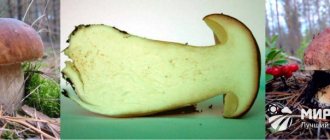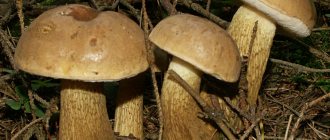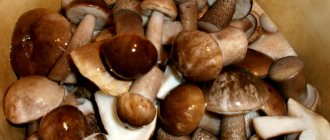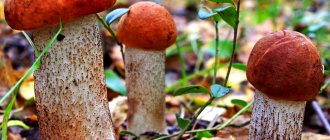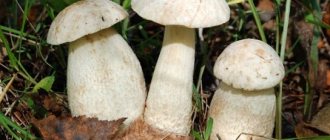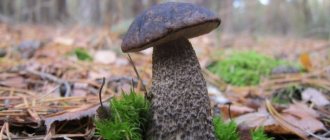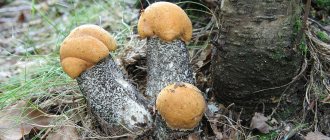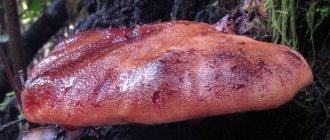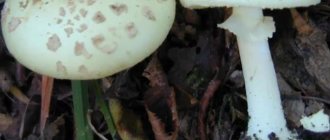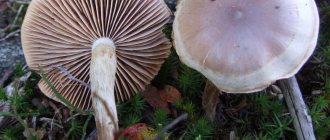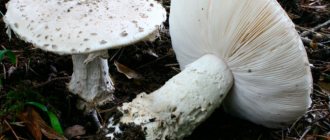One of the favorite and most recognizable mushrooms is boletus. Its bright cap is reminiscent of autumn foliage and can be any shade from beige to bright red. This mushroom is easy to find among green grass. But it is important to know that there are several varieties of boletus mushrooms, including the false aspen mushroom. This is not some independent type of mushroom culture, but several representatives.
What white false boletuses look like and how to distinguish them from other mushrooms (with photo)
Latin name: Leccinum.
Genus: Leccinum (Obabok).
Family: Boletaceae.
Synonyms: false white boletus, aspen boletus, redhead.
Cap: medium-sized, rounded-convex, fleshy, can be red-brown, yellow-red and red-orange. When young, the inside of the cap is white, but with age it becomes grayish.
Leg: slightly swollen, irregularly shaped, thickened at the base. On this part of the fruiting body there is a pink or yellow mesh. The surface is covered with small dark brown scales, and the inner layer has a tubular consistency; when cut, it changes color from white to pink. On the legs of any species of boletus, including false aspen, the membranous ring is completely absent. A visual photo will show how to distinguish false boletuses from edible ones.
Pulp: Unlike the flesh of a real boletus, which is white and blue in color, that of a false mushroom is pink. The bitterness of the pulp is very strong, even with heat treatment it is not eliminated.
Edibility: although false boletus does not contain toxic substances, it is impossible to eat due to its bitter pulp. False boletus does not pose a significant danger to human health and life
However, it is important to note that the bitterness of these mushrooms, when consumed, is converted into toxins and settles in the liver, thereby disrupting its functioning, which can cause intoxication
Similarities and differences: the shape of the pepper plant is very similar to some edible representatives. In addition, due to the peculiar mesh pattern on the stem, it is called false white boletus.
Distribution: the first white false boletuses appear in June, but their growth does not last long. The end of July is considered the second growing season of mushrooms and it lasts longer than the first. The third peak of boletus collection occurs in mid-October and lasts until the first frost on the soil. It grows only in coniferous forests and forms mycorrhizae with these tree species.
Varieties and their features
- Red aspen (Leccinum aurantiacum) is noticeable from afar: it has a stocky body, a scarlet cap and a powerful white leg. If the mushroom is damaged, it may take on a slight blue tint, which looks somewhat scary;
- Yellow-brown (Leccinum versipelle) is the largest of all boletuses; the cap has been recorded to reach 30 cm in diameter. Some people are afraid to collect it, but the mushroom is completely harmless;
- White (Leccinum percandidum) becomes grayish as it grows. It has a strange and scary appearance, but is legal to eat. When broken it also turns blue or black;
- Oak (Leccinum quercinum) is a powerful mushroom with a spherical shape. Its cap gradually grows to 30 cm, and the height of the fruiting body reaches 22 cm. Unfortunately, its lifespan does not exceed 11 days, so it is difficult to find;
- Pine (Leccinum vulpinum) has a miniature round cap with a brown-red skin. Over time it acquires a pleasant raspberry hue. The flesh also becomes a little darker, but this is absolutely normal;
- Painted-footed aspen (Leccinum chromapes) differs from other aspens. It has a soft pink cap and a yellow base. This variety is rarely used by humans, because most often it is affected by pests.
Tips and tricks from experienced mushroom pickers
Experienced mushroom pickers, aware of the smallest nuances and differences between true and false boletuses, give beginners some more advice:
- When collecting, you should not focus solely on the shade of the cap. Depending on the age, growing conditions and even lighting in the forest, false boletuses may have a reddish skin color, but the characteristic shade of the true boletus may be barely noticeable. It’s better to look at the differences in structure and the flesh on the cut.
- Although false redcaps have an unpleasant odor, it is not always noticeable. To make sure that the fruiting body is inedible, it is better to lightly lick its flesh. Since the doubles are not poisonous, this will not cause harm, and will clarify the situation.
Mushroom pickers also note that false boletuses with a bitter or pungent taste usually look much more attractive than true redheads. They are distinguished by smooth caps and legs, untouched by insects, and make you want to cut them off and put them in a basket. However, midges and worms do not eat false caps precisely because their flesh is too bitter, but the edible red cap is of interest to both humans and insects.
Why does the boletus turn blue (darken) when cut?
The transformation of the white flesh of the boletus into blue-violet when cut occurs as a result of the oxidation process, which consists of the interaction of oxygen with the substances contained in the mushroom. Similar reactions are also typical for fruits and some vegetables; for example, if you cut an apple, after a while its flesh will acquire a brownish tint. This answer will be sufficient if you do not want to go into details of chemical reactions. But still I wanted to get more detailed information on this issue.
After reading various literature, you can find out that boletus contains a certain pigment - variegated acid. The composition of this pigment includes substances of the phenolic group, which, when interacting with oxygen, are oxidized to the quinomethide anion, which has a blue color, which is what is responsible for the appearance of the violet-blue color on the cut of boletus pulp. It is worth noting that in its pure form, variegatic acid does not acquire a blue color so quickly, and therefore, in addition to the effect of oxygen, the enzymes contained in the pulp of the mushroom also have an effect, they accelerate the process of its darkening on the cut.
What is the danger
This mushroom is considered conditionally inedible. No, it is not poisonous, but you are unlikely to be able to eat it, and in large quantities. As mentioned above, its flesh is very bitter (it’s not for nothing that the mushroom is called bitter).
Even if you manage to overcome this taste with some special marinade or strong seasoning, it is still not recommended to eat it. After all, the bitterness of the gall fungus is converted into toxins, which then settle in the liver and disrupt its proper functioning. This does not bode well for health.
If you regularly eat true aspen boletus, it helps remove toxins and waste from the body. And the broth from these mushrooms helps restore the immune system after illness and has a good effect on the composition of the blood in case of low hemoglobin.
What is the danger
This mushroom is considered conditionally inedible. No, it is not poisonous, but you are unlikely to be able to eat it, and in large quantities. As mentioned above, its flesh is very bitter (it’s not for nothing that the mushroom is called bitter).
Even if you manage to overcome this taste with some special marinade or strong seasoning, it is still not recommended to eat it. After all, the bitterness of the gall fungus is converted into toxins, which then settle in the liver and disrupt its proper functioning. This does not bode well for health.
If you regularly eat true aspen boletus, it helps remove toxins and waste from the body. And the broth from these mushrooms helps restore the immune system after illness and has a good effect on the composition of the blood in case of low hemoglobin.
Edible mushrooms such as aspen mushrooms, white mushrooms, boletus, russula, champignons, moss mushrooms, pig mushrooms, black milk mushrooms, porcini mushrooms and honey mushrooms are sources of biologically valuable food components: proteins, fats, carbohydrates, vitamins and microelements.
Twin mushrooms
Some mushroom lovers are afraid of being poisoned by false boletus. Others generally doubt that false boletus mushrooms exist in reality. Which one is right? There really is no such species. All boletus “doubles” are edible and do not pose a health hazard. Let's see how this mushroom differs from each of them.
Collecting boletuses is not difficult, since they grow in “families” and, if you see one, you can pick up a whole “cart” at once, if you’re lucky. You need to cut at the base so as not to damage the mycelium. You should not take only old mushrooms, as they will have time to spoil before the mushroom picker brings them home.
Some housewives are faced with the question of what to do with blue mushrooms that are different from the boletuses they saw in the photographs? After harvesting, boletus mushrooms must be processed and cooked immediately! If the mushrooms have lain for more than two days, even in the refrigerator, all that remains is to throw them away. If you plan to prepare them for salting, pickling or frying, you must first wash them, then clean them and remove possible worm damage, and then boil them in two waters. They do not wash it for drying, but they must clean it, preferably with a brush. Small fruit bodies are good to pickle or salt; large ones are preferably fried, stewed or dried. Mushrooms have an excellent taste and go well with other foods, in particular potatoes, buckwheat and rice. Good in soups and salads. You can “roll” mushroom spawn.
Boletuses in the forest
Boletus yellow-brown
It is considered the largest of the boletuses. In some adult specimens, the cap size reaches thirty centimeters in diameter! It has a yellow-brown hemispherical cap and a white leg covered with black-brown scales. This mushroom grows in mixed forests, where, in addition to aspens, birch and spruce predominate. Rocky, sandy or peaty soil is more favorable for it. A distinctive feature of this boletus is that its dense, white flesh turns pink at the break and then turns purple. The yellow-brown boletus appears in June and grows until October.
Boletus yellow-brown
Red boletus
Most often it grows in aspen forests from June to October. It has a red or brownish-red cap with white, dense flesh, which turns purple at the break and later almost black. The stem of the mushroom is white with almost the same scales.
Red boletus
White boletus
It is found in mixed forests where birch, aspen, and pine grow. It appears in late summer and autumn. This mushroom has a white cap and the same white stem. At the break, the flesh turns pink, and later becomes black-brown.
White boletus
Oak boletus
has a velvety red-brick cap. It grows in mixed forests dominated by aspens and oaks. All boletuses love edges, clearings, and damp places. Boletuses grow in shady places, hiding under fern leaves. Boletuses grow very quickly, but they deteriorate just as quickly. Therefore, young mushrooms are collected, which are called chelas. Young boletuses have a cap that looks like a thimble placed on a finger. Old boletuses, even if they are not wormy, are avoided, since they can begin to deteriorate while still in the basket.
Oak boletus
Moreover, mushrooms strongly absorb harmful substances, especially radioactive ones, both from the soil and from the air.
Reviews about collecting boletuses
Marinka, 42 years old. An avid mushroom picker. I love boletus mushrooms! This is my favorite mushroom! During a trip to Karelia in July 2022, we found ourselves at the very peak of the mushroom harvest and mowed down redheads without leaving the camp. I have never found so many mushrooms in my life! They could even go out into the forest in the evening (after 21:00) and pick a basket, fortunately, the boletuses are clearly visible on the green carpet of moss. It is extremely rare to see wormy specimens. They made soup from boletus mushrooms, fried them with potatoes, and took several cans with them. Perfect mushrooms!
yana86, 32 years old, Voronezh. Every year at the end of summer and beginning of autumn I come to the dacha to pick mushrooms. My sister and I go to our favorite place, a birch grove, where there is a lot of tall grass and moisture. Mostly boletus mushrooms are found there - delicious mushrooms that are easy to find. Among them we came across false specimens that tasted bitter. If you break off the cap and taste the pulp on your tongue, it will immediately become clear what is wrong. We simply threw away such mushrooms; we only got 2-3 out of the entire basket.
Hide
Add your review
Knowing how to distinguish real aspen trees - regardless of the color of their cap, stem and place of growth - any mushroom picker will be able to get a truly valuable trophy from the forest, and not a mushroom with dubious taste, which can also cause harm to health. Knowing what a good mushroom should and should not look like, a fan of the “quiet hunt” will not make a mistake.
Common boletus
Cap of the common aspen boletus (Leccinum aurantiacum) (diameter 5-28 cm): brown with shades of red or orange. It has the shape of a hemisphere and is easily separated from the leg. The peel is difficult to remove and only contains pieces of pulp. Leg (height 4-18 cm): solid gray or off-white. Photo and description of the leg of the common boletus is similar to the leg of the oak boletus - it has the same fibrous scales, which become almost black over time.
Tubular layer: loose, white, yellowish or olive in color. Old or wormy mushrooms are dirty gray or brownish. Pulp: fleshy and dense; in a young mushroom it is elastic, while in an old one it is soft and loose. When cut, it is immediately white, after a few minutes it becomes bluish, and then turns black. Does not have a distinct aroma.
Common boletus
Look-alikes: edible yellow-brown boletus (Leccinum versipelle) and colored-legged boletus (Tylopilus chromapes). The yellow-brown one has a lighter cap and flesh, which first turns pink, then turns blue when cut, while the colored legged one has a yellowish leg.
When it grows: from early June to mid-October in many countries of Eurasia, the Caucasus, the Far East, the Urals and Western Siberia.
Where to find: in deciduous and mixed forests. Prefers proximity to aspens, willows, birches, oaks and poplars. Never grows near coniferous trees. Occasionally can be found in clearings, not far from aspen forests.
Eating: in almost any form, only when frying, drying and cooking it becomes very dark.
Use in folk medicine (the data has not been confirmed and has not undergone clinical studies!): in the form of a tincture - an excellent remedy for cleansing the blood and skin, which is considered effective against acne. Other names: red mushroom, red mushroom, red mushroom, red mushroom, aspen mushroom. Depending on the time of appearance, people call the common boletus “spike boletus” (if it is an early mushroom), “stubber” (this is what the later aspen boletus is called), and the season ends with “deciduous mushroom.” What does the oak boletus mushroom look like?
Material on the topic: Description of the mushroom: ringed cap
Cap of oak boletus (Leccinum quercinum) (diameter 6-16 cm): chestnut, brown or slightly orange, in the shape of a hemisphere or swollen pad. Leg (height 8-15 cm): brown or brown, often with small scales. Cylindrical in shape, slightly thickened at the base.
- Tubular layer: brown, with very fine pores.
- Pulp: very dense, white, with brown or grayish spots. It turns black at the cut site and when exposed to air.
- Doubles: none.
- When it grows: from the beginning of August to the end of September in the countries of the northern temperate zone.
- Where to find: most often in oak forests.
- Eating: very tasty in almost any form.
- Use in folk medicine: not used.
- Other names: red-headed oak, oak-headed oak.
Similarity of common boletus with other mushrooms
The common boletus belongs to the genus of boletus, bears fruit on sandy and clayey soils in deciduous and mixed forests, preferring the neighborhood with birch trees. This is not a meadow mushroom, but can be found on lawns near the forest near birch trees.
External features:
- The cap is hemispherical or cushion-shaped. It can grow up to 15 cm in diameter. The surface is smooth; in damp weather, mucus forms on it. The skin color can vary from light gray to dark brown. The color depends on the type of neighboring trees and growing conditions.
- The pulp is white and emits a pleasant aroma. The shade does not change on the cut. At the break, another variety turns pink - pink boletus.
- The leg has a cylindrical shape, a grayish-white surface with longitudinal dark or light scales. It becomes tougher with age.
- Birch grass is not a lamellar, but a spongy species (the tubular layer is similar to a sponge). In young mushrooms, the bottom of the cap is white, in old ones it is a dirty gray shade and becomes fibrous.
Mushrooms similar to boletus mushrooms are boletus mushrooms. The difference between the latter is the following: if you cut the mushroom, the flesh will turn blue.
Other features of boletuses include a leg of uniform thickness along the entire length and a cap of orange or red shades. Mushrooms are edible; misidentification will not cause negative health consequences.
Externally, other varieties of boletus are similar, they can be eaten, they all have good taste characteristics. Bitterweed, similar to normal boletus and boletus, deserves special attention
It is important to know how to distinguish a regular mushroom from a double so as not to spoil the dish and avoid poisoning
Boletus - benefits and medicinal properties
Boletuses are stewed and boiled, pickled and fried, frozen and dried - in any form these gifts of the forest are good and tasty. To prevent boletuses from darkening (turning black), they are soaked in a 0.5% citric acid solution before cooking. What are the benefits of boletus for the human body?
- Like most mushrooms, 90% of the mass of boletus consists of water. Proteins make up about 4%, fiber - up to 2%, carbohydrates account for 1.5%, fats contain no more than 1%, and 1.5% of the composition of the mushroom comes from minerals.
- The calorie content of boletus is only 22 kcal, so this mushroom can be considered as one of the components of dietary nutrition. Combined with a zero glycemic index, these red mushrooms are recommended for people suffering from diabetes.
- Boletus protein contains a significant amount of essential amino acids for humans, which are absorbed by the body by 80%. In this useful property, mushroom proteins are similar to animals, so broth from young boletuses is deservedly compared to meat broth.
A significant amount of vitamins was found in red cap mushrooms: in terms of vitamin B content, boletus mushrooms can be compared with cereal crops, and the amount of vitamin PP is the same as in the liver. Boletuses also contain vitamins A and C. The predominant substance in the mineral composition of boletus is potassium; to a lesser extent, the pulp of the mushroom contains magnesium, phosphorus, calcium, sodium and iron.
- Scientists have proven that regular consumption of boletus helps remove toxins and waste from the body.
- Boletus broth will help restore immunity after viral diseases, and also has a beneficial effect on blood composition in case of anemia.
How long does the boletus grow? When to collect?
Boletuses occupy a leading place in terms of growth rate. For example, a mushroom can grow a couple of centimeters in a day. Weather conditions affect the growth rate of boletuses.
Stages of boletus growth - from the youngest to the most mature mushroom
After a heavy rain within a day, they become quite impressive in size, since they quickly absorb moisture from the soil and all useful substances. By the way, the absorption of harmful substances by mushrooms also occurs, so it is very important to collect them only in environmentally friendly areas.
Interesting fact : the lifespan of mycelium (mycelium) reaches 80 years. In order for boletuses to grow in the same place repeatedly, they should be collected carefully.
If it rains frequently, then the collection of redheads can continue throughout the summer and autumn until it gets colder. After the rain, just wait a day - the mushrooms will already have reached the desired size. If cold weather persists, the red mushroom takes 3-4 days to reach its optimal size.
How to distinguish boletus from false mushrooms
If you carefully study the characteristics of the boletus and photographs of its doubles, then you can deduce several basic characteristics of false boletuses.
The true redhead has a tall, dense and light-colored leg, covered with recognizable gray scales. A real aspen tree should not have a yellowish or reddish network or “vessels”; these are signs of false doubles.
If you break the redhead in half, its flesh will remain white or slowly turn blue or black. If the mushroom looks like a boletus and turns pink or red when cut, then it is a double.
The raw pulp of true aspen has a neutral taste and does not bring any unpleasant sensations. Inedible doubles taste bitter or hot, and there is no desire to eat them.
In size, a real boletus is quite large - about 15 cm in height and the same in diameter of the cap. Some of the look-alikes, such as the pepper mushroom, are much smaller.
Pine
Pine redhead creates mycorrhizae with pine trees and the bush plant bearberry. The cap is convex or flat, up to 15 cm. Its distinctive feature is considered to be a red-brown shade with a clearly visible pink tint.
Pine boletus
The leg grows up to 15 cm with a thickness of 4-5 cm. It also has brown scales. Like the red mushroom, the flesh of the pine one turns blue and then turns black when broken.
Based on the name, this species is common among coniferous varieties, especially pine. It requires moisture, dampness, and a minimum of light. It is easy to confuse it with the red boletus and is the second most common species.
What is the danger
This mushroom is considered conditionally inedible. No, it is not poisonous, but you are unlikely to be able to eat it, and in large quantities. As mentioned above, its flesh is very bitter (it’s not for nothing that the mushroom is called bitter).
Even if you manage to overcome this taste with some special marinade or strong seasoning, it is still not recommended to eat it. After all, the bitterness of the gall fungus is converted into toxins, which then settle in the liver and disrupt its proper functioning. This does not bode well for health.
If you regularly eat true aspen boletus, it helps remove toxins and waste from the body. And the broth from these mushrooms helps restore the immune system after illness and has a good effect on the composition of the blood in case of low hemoglobin.
Information about symptoms of poisoning
There are few toxic substances in the false mushroom. However, it still contains quite a lot of toxins. They have an extremely negative effect on the liver. True, even if you eat a lot of these representatives of a separate kingdom, it is unlikely to lead to death. If you are poisoned by inedible boletus, you will feel the following symptoms:
- weakness and dizziness - you will want to lie down and sleep, but these symptoms will quickly pass;
- the process of bile secretion will be disrupted;
- the liver will begin to hurt, and the process of cirrhosis will begin.
The most dangerous thing about their use is that often people themselves do not even understand that the poisoning has occurred. Only a few months later they turn to doctors due to the discovery of cirrhosis. Even professional doctors sometimes cannot understand the cause of the disease. Therefore, let us remind you once again that under no circumstances should you collect mushrooms that you do not know; you need to study information about them and watch useful videos that will help you understand how to identify false boletus.
Are there false boletuses?
Boletus, aspen, obabok or redhead is considered a unique mushroom, which is almost impossible to confuse with other varieties. His appearance is very recognizable. The redhead has no poisonous counterparts and belongs to the category of the safest.
But at the same time, it is still possible to confuse obabok with inedible fruiting bodies; they do not pose a danger, but they have a very unpleasant taste. There is no specific mushroom with the name “false boletus” in nature. This word is used to describe other mushrooms that have their own names, but are very similar to redhead in external structure.
Differences between edible boletus and false aspen
Externally, these mushrooms are very similar, so to recognize the “impostor”, pay attention to some nuances
- One way to identify a fake boletus is to look at the color of the flesh. As you remember, in bitterling it has a pink tint, but in real aspen the flesh is white or bluish.
- Another difference: the leg of bitterling is decorated with a pinkish or yellowish mesh (similar to porcini mushrooms). The true boletus does not have this.
Remember also that pepper mushroom is found only in coniferous forests.
| Name: | Boletus |
| Type: | Edible |
False boletus is a mushroom that is very similar to the real boletus in its external structure, but is not suitable for consumption. This is usually the name given to not just one mushroom, but several varieties, so as not to bring inedible fruiting bodies from the forest, it is necessary to carefully study the false doubles.
Yellow-brown boletus photo
It is often found throughout the forest zone in dry mixed forests (birch-aspen and spruce-birch), sometimes under the fan leaves of fern, often singly. It grows from the first half of June until the end of leaf fall, until frost.
The cap is convex, later cushion-shaped, sometimes with the skin hanging down along the edge, the color is yellow, orange or brownish-yellow. The tubular layer is finely porous, initially white, later dirty-whitish. The leg is massive, stocky, thickened at the bottom, solid, white with black scales, grows faster than the cap - on the second day it rises to 4 cm. The flesh is white, strong, at the break it first turns pink, then turns blue and becomes almost black, without much taste or smell. The mushroom turns black when dried.
Types of mushrooms
Mushrooms are a very difficult product for the human body to digest, for this reason they should not be consumed in large quantities or eaten at night. Also, before use, it is better to chop them well and cook them thoroughly, then they will be better absorbed. At the same time, they can impart a unique taste and aroma, promoting better digestibility and absorption of food.
Mushrooms can be used as a seasoning and can be ground into dried mushroom powder. It is added to the dish before the end of cooking.
Based on their taste, they can be divided into four categories:
I. The first category includes the most valuable and tasty species that produce mushroom products of excellent quality (for example, white - birch, oak, pine, spruce; camelina and milk mushrooms - white and yellow).
II. Good and quite valuable mushrooms, but somewhat inferior in quality to the previous ones, are classified in the second category (boletus, boletus, milk mushrooms - blue and aspen).
III. The third category of mushrooms includes species that are not very bad in taste, but also not very good, those that are collected only in “mushroom-free” conditions, when the best mushrooms are few (blue russula, autumn honey fungus, mossy mushroom).
IV. The fourth category includes those mushrooms that most mushroom pickers usually bypass, and in rare cases only a few amateurs collect them. These are mushrooms such as oyster mushrooms - common and autumn, green russula, ram mushroom, swamp butterfly.
Some interesting information about mushrooms
Curious facts about mushrooms are based on human knowledge of only a tenth of the properties of these amazing forest inhabitants:
- On average, each mushroom consists of approximately 90% water.
- There are flying varieties. These are biological microscopic species, which include, for example, mold, which appears in such an easy way even on products.
- The mycelium grows at a speed of at least 10 centimeters in just 1 year.
- Just one specimen of the toadstool contains enough poison to poison four people.
- There is evidence that on the territory of the former Chernobyl nuclear power plant, mushrooms grow well, despite the high level of radiation.
View gallery
And now let's take a closer look at one of the interesting edible specimens. The boletus, a photo and description of which you can see in our article, is not for nothing considered one of the most delicious mushrooms.
Description of false
Not all lovers of “quiet hunting” know that there is a double of the boletus, considering this species to be quite unique. But in nature there is still a mushroom very similar to it.
hat
His hat is of medium size, it is round-convex and fleshy. It comes in different colors: red-brown, yellow-red, red-orange. In young mushrooms, the inside of the cap is white, but with age it becomes grayish.
Leg
It is slightly swollen, irregularly shaped, thickened at the base. This part has a pink or yellow mesh. The surface is covered with small dark brown scales, and the inner layer has a tubular structure; when cut, the white color changes to pink.
Paintedfoot
It stands out noticeably from others in appearance. It has a large convex or almost flat cap of a pink-brown hue. The leg is creamy pink, covered with red or pink scales.
Interesting: Honey mushrooms
